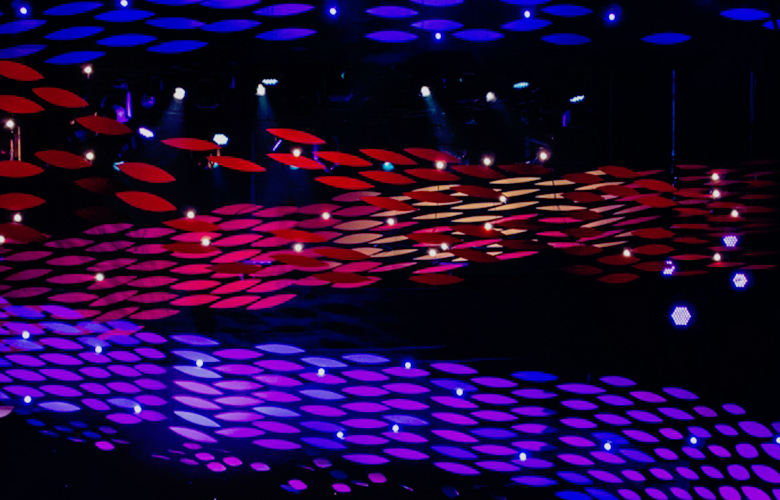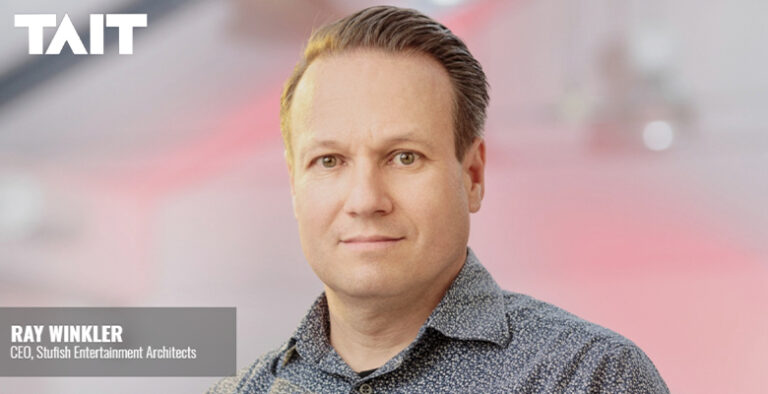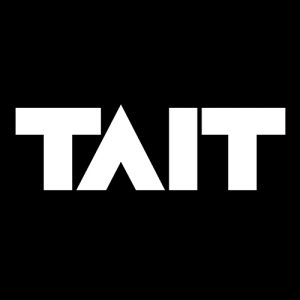
With more than two decades in the live event industry, Ray Winkler, CEO of Stufish Entertainment Architects, continues to push the creative boundaries of entertainment architecture with seamless, elegant designs for live shows. Winkler’s design style was influenced by the late Mark Fisher who inspired him to specialize in kinetic architecture and stage design. A natural fit for his works’ execution is a collaboration between Stufish Entertainment Architects and TAIT. The two companies have worked together since the early 90’s and most recently kicked off Elton John’s Farewell Yellow Brick Road Tour together.
This past month, Winkler was back at TAIT to collaborate on Elton John’s Farewell Yellow Brick Road Tour. Kierston Powell, Marketing Coordinator at TAIT, sat down with Winkler to discuss his career, inspirations, and design processes.
I am an entertainment architect at Stufish. I have been at Stufish for close to 22 years.
The story goes back to when I was still at The Bartlett School of Architecture-University College London studying architecture. I was working, during my summer breaks and various other breaks from school, with a company called, Atelier One. Atelier One is an engineering company that specializes in lightweight, portable architecture. They were Mark Fisher’s engineering company of choice. Over the several years I was working at Atelier One, I was exposed to more and more of Mark’s work and eventually, there came a point when I started to work directly on Mark’s projects.
As coincidence would have it, Mark Fisher ended up being my external assessor for when I was presented my diploma work at the University. As a result of Mark slating my work, I was about to change my career and leave the country, but eventually, the dust settled and I had gotten my diploma which is when Mark offered me a job. I was a bit surprised that Mark asked me to join him at his studio, but I took the opportunity and ran with it.
Mark Fisher was a huge mentor for me, but when I got his job offer, I was a bit apprehensive because I didn’t know where it was going to lead me. I was very fortunate though because the first project I got exposed to under Mark Fisher was U2’s PopMart in 1996. It was ironic because I actually started working on that project when I was at Atelier One, so it was nice to finish the project while working at Mark’s studio. It was a really nice transition. In the end, working at Mark’s studio allowed me to work on such great projects and really understand how Mark developed his work. Working with Mark was a great inspiration for me. My first year segued from working on PopMart straight into the Rolling Stones’ Bridges to Babylon, so I had one hell of a year and it was really good fun.
I went to The Bartlett School of Architecture which is part of the University College London. I completed my degree there and for my Master’s I went on an exchange program to SCI-Arc which is Southern California Institute of Architecture in Los Angeles. That’s where my interest in set design and ephemeral and portable architecture was sparked. I did a stint in LA and then I came back to London to get my diploma. Prior to that, I was a furniture designer and craftsman. I completed a 3D course in furniture making so I had a very practical approach to design which was one of the reasons that I think I got along with Mark so well. In spite of Mark’s huge intellectual capacity and also his creative artistic skills, he has always been interested in working things out and making the design work. I think that’s how his relationship with Michael Tait sort of sparked off as well, because they were both very practical men and that working relationship continued till the end of Mark’s life.
That’s sort of one of those elusive things. You never know where the inspiration comes from, but, you know it’s a good thing when you instinctively feel it in your work. I don’t think that you could ever claim to be the sole instigator or author of an idea. I think that’s a very important part of working at Stufish and also working with TAIT. We are very collaborative people and we have to be generous with throwing ideas into the mix and not be afraid of those ideas being rejected.
Mark Fisher was incredibly generous in sharing ideas, skill sets and techniques with his collaborators. In our world, the idea is only ever as good as the ability to realize it and for that, you need to collaborate with others to bring that idea to life.
It’s very easy to come up with a wacky idea and have everyone think it’s a great idea. What becomes challenging is knowing what to do with an idea. You need to collaborate and share the idea with other people in order to figure out how the hell to do it – that’s when the real magic happens.
At Stufish, Mark leads the direction that ‘if you have an idea, you have to know what to do with that idea and you have to realize it or else it will get watered down, it will transform, and you will end up with something different than what it started off with.’ With working with a team of designers who are all incredibly talented architects, ideas can fly and spark off other ideas so the inspiration can be very elusive.
The process is always different regardless of the project. We don’t have a template and as a result, we don’t have a house style. Stufish is a design studio that has a huge range of design projects. One day, we could be working on a lectern for a ship launch and the next day, we could be working on a building in China and everything in between. There is no applicable process to say ‘this is how we do it’ at Stufish.
In spite of having said that, we do have a pretty rigorous way of proceeding with projects and that is that we very quickly test our ideas by using 3D computer modeling and often times through animations if there is a kinetic aspect to the project. We use these tools as a means to an end rather than as an end itself. The process focuses more on sharing our open book approach with the client and making them privy to how we proceed with projects and letting the client take authorship in that.
When we present something to a client, we are looking to engage with them and ultimately get their feedback on the concept or design. So the process varies from client to client, but the outcome of a Stufish project is always that we hope to achieve the highest level of the aspiration that the client had come to us with in the first place.
It does differ from client to client. Some clients just let you go and get on with it. Other clients are like art directors and want to engage with the project as it evolves. They can become quite involved in the design process and quite like the idea of being able to contribute.
To speak on behalf of Stufish, I believe what keeps us motivated is that our team has a passion for what we do. If you’re passionate, what else do you need to keep you motivated? We love the idea of not quite knowing what each day will bring. Sometimes, the best laid out plans on a Monday are completely scrapped on a Wednesday because there is a new challenge that arose and we have to focus on overcoming that challenge. There is a lot of motivation in the sense that there is very little routine.
Stufish is not a big company, we are just under 20 people. We are all quite content and condensed into our small studio in London and being able to come up with elaborate and interesting shit is great. I mean who wouldn’t want to dream up some of the things that we do on a daily basis?
You have to passionately be involved in the work that you are doing. This is a lifestyle choice, not a career choice. Certainly, in the architectural world, it’s the passion that drives you. If you want to make loads of money, then you are probably better off being a plumber, or a brain surgeon, or a lawyer. But, if you want to lead a life that is passionate about what you are doing, then the design world and the projects that we do with TAIT is really driven from the heart.
My advice would be, don’t go into architectural school with a preconception of what you think architecture is and what you want out of it. I would advise you go to an architectural school with a blank slate and absorb the environment that is around you. In architectural schools, you are surrounded by some of the most talented fellow students, professors, and lectures that you can wish for. So learn and absorb as much as you can. Don’t be deceived by thinking “Oh, I only want to do this kind of architecture or this specific interest” because you will cut yourself off from all the other opportunities out there.
It’s the opportunities and the excitement of not knowing where these opportunities are going to take you that will lead you to find your passion. If you shut yourself down before having the opportunity to explore these opportunities, you are missing the point about how to live a creative life.
A creative life is a great journey into the unknown.
When we start a project, there is no way of telling how it will end, other than, it will eventually end and it will be in the public domain. But, what exactly the project ends up being is often not clear from the very beginning. That’s what makes it exciting.

Also by TAIT:
Metallica’s Show Director: Dan Braun – The Importance Of Collaboration
Sr. Director Sam Brown talks Operations at TAIT


TAIT is the World Market Leader in designing, constructing and delivering the finest live event solutions in the world. Whether it’s creating awe-inspiring spectaculars, complex touring stages, theatre engineering solutions, brand activations or cruise ship installations, TAIT delivers world-class solutions for live experiences. With its proprietary entertainment automation platform, custom-made products, and creative engineering, TAIT’s cutting-edge offerings continue to advance industry standards and exceed client expectations. As a global network of over 600 employees in 12 office locations, TAIT has worked on projects in over 30 countries, all 7 continents and even outer space. TAIT’s diverse group of clients include Taylor Swift, Cirque Du Soleil, The Metropolitan Opera House, NASA, National Geographic, Beyoncé and The Olympics. TAIT Talks is a blog curated by TAIT's leadership team with talking points that include industry insights, trending topics, how-to’s, challenges, solutions and more.
Read Full Profile© 2021 TheatreArtLife. All rights reserved.

Thank you so much for reading, but you have now reached your free article limit for this month.
Our contributors are currently writing more articles for you to enjoy.
To keep reading, all you have to do is become a subscriber and then you can read unlimited articles anytime.
Your investment will help us continue to ignite connections across the globe in live entertainment and build this community for industry professionals.